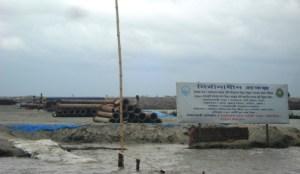
Land filling and land preparation are taking place in Bangladesh’s Sundarbans for a planned 1,320 megawatt coal-fired power plant. THOMSON REUTERS FOUNDATION/Syful Islam
Syful Islam / Trust.org
DHAKA (Thomson Reuters Foundation) – Environmentalists and activists are protesting the Bangladesh government’s plan to build a massive coal-fired power plant close to the Sundarbans, the world’s biggest mangrove forest and a World Heritage Site.
They say the authorities have not considered the impact of the plant on the Sundarbans’ ecosystem and the forest’s role as a valuable coastal defence against extreme weather – such as the two cyclones that battered the area in 2007 and 2009, affecting millions of people and severely damaging buildings and cropland.
Coal-fired power also is a heavy contributor to climate change, and Bangladesh is considered one of the world’s most vulnerable countries to impacts of climate change, including sea level rise, changes in weather patterns and more severe storms.
The 1,320 megawatt power plant, to be built within 14 km (9 miles) of the Sundarbans, will be jointly funded by Bangladesh and India under agreements signed last April. The Sundarbans lie mainly along the southwest coast of Bangladesh but a small portion is in Indian territory.
The Convention on Wetlands of International Importance, the Ramsar Convention, has said it believes the biodiversity of the Sundarbans will face tremendous challenges once the plant goes into operation, and has expressed its concern and asked the government for detailed information on its plans.
The 1971 Ramsar Convention is an intergovernmental treaty that provides the framework for national action and international cooperation for “the conservation and wise use of all wetlands” and their resources.
Bangladesh has sizeable coal reserves, and a consultant for the project said the government had no option but to go for coal-fired plants to meet the growing demand for electricity in this impoverished nation because the alternatives were more expensive.
COAL CHEAPER
“Electricity generation with fuel oil or gas is much costlier than coal. Besides, the country’s gas reserve is very nominal. So we have no other scope but to use coal for power generation,” said consultant Azizur Rahman.
Efforts will be made to minimise the impact of the project on the environment and on the Sundarbans, he said. “With modern technologies, many developed countries nowadays even have coal-based power plants inside their cities,” he said.
The government meanwhile announced a 15-year tax waiver to attract private companies interested in bidding for electricity production contracts. Companies will enjoy the waiver if they sign contracts with the government by June 30, 2020, provided they start generating electricity by June 30, 2023.
The initial environmental examination of the Sunderbans project was carried out by a government organisation, the Water Resources Ministry’s Centre for Environmental and Geographic Information Service, which the environmentalists charge is not an impartial body.
This was followed by an Environmental Impact Assessment, but before this had been completed authorities evicted 2,500 families from the 1,830 acres of land acquired for the plant and began filling in 250 acres of the land.
Sushanto Kumar Das, president of the Farmland Protection Committee in Rampal, told the Thomson Reuters Foundation that people evicted from the project area had lost their incomes.
“The farmlands were producing both paddy (rice) and fish. More than 3,500 families were dependent on the lands,” he said.
Das said the mangrove forest had saved the coastal area during fierce storms, but would be at risk from smoke and ash fallout from the plant. If it is lost, “the area, close to the sea, will be hard hit by storms,” he said. He said he also feared that water use for the plant from the Pashur River would leave less drinking water available for people living in the area.
Abdullah Harun Chowdhury, an environmental science professor at Khulna University, told the Thomson Reuters Foundation by telephone that the government had ignored the impact of the power plant on the ecosystem and wildlife of the Sundarbans.
INDIA’S ROLE
He said that India, facing massive protests and legal barriers, had failed to build two coal power plants planned for the states of Gujarat and Madhya Pradesh. “So India has arranged for Bangladesh to build a coal-fired plant in Rampal as an experiment, to set an example for those (it wants to build) in 2017,” he said.
The Bangladesh government did not consider the impact of the plant on the environment and the forest in this case, Chowdhury claimed. The forest, he said, may be vulnerable to ‘acid rain’ from chemicals released by the plant, and chemicals could also cause human health problems.
Chowdhury suggested setting up several tidal power plants in coastal areas instead of a coal-based plant, taking into account the environmental and climate impact.
Abdul Matin, member secretary of the ‘National Committee to Protect Sundarbans,’ said the government’s decision to build a coal power plant was self-destructive.
“The government is setting up a coal power plant and shipbuilding industry near the Sundarbans which will destroy the forest – a shield during cyclones and other storms. The government should immediately cancel the decision,” he said.
Syful Islam is a journalist with the Financial Express newspaper in Bangladesh. He can be reached at: [email protected]

